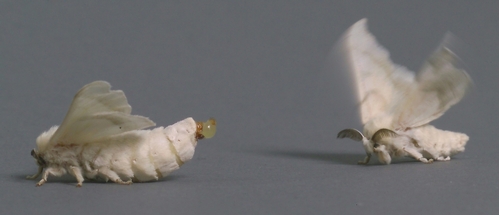The female silkworm moth releases a sex pheromone, bombykol, that's very enticing to the male. He can detect it from miles away.
Now researchers in the UC Davis Department of Entomology have discovered that the fruit fly has a native odorant receptor that detects the silkworm moth’s sex pheromone, and that it’s “amazingly more sensitive” than the moth’s odorant receptor.
Their work could open research doors for insect-inspired biosensors.
Walter Leal, professor of entomology, and postdoctoral scholar Zain Syed know the olfactory systems of silkworm moths (Bombyx mori) and fruit flies (Drosophilia melanogaster) well.
In a serendipitous discovery, the chemical ecologists found that the fruit fly’s odor detector not only detects bombykol, but responds to bombykol with high sensitivity. Their groundbreaking research, Bombykol Receptors in the Silkworm Moth and the Fruit Fly, was published May 3 in the Proceedings of the National Academy of Science (PNAS).Their research follows on the heels of another study they published in PNAS in 2006 with the Deborah Kimbrell genetics lab in the UC Davis College of Biological Sciences. Bottom line: they found that genetically engineered fruit flies responded to the silkworm moth scent of a female.
Now Leal and Syed have identified the odorant receptor in the male fruit fly that detects the sex pheromone.
Ecologist and evolutionary biologist Fred Gould of North Carolina State University, not affiliated with the research, says the work of the UC Davis researchers "provides important guidance and tools for other researchers who want to explore the pheromone communication systems of other species, or who want to further dissect the mechanisms within the specialized hairs of silkworms that enable this high sensitivity.”What we have here with the silkworm moths and fruit flies is definitely not a "failure to communicate."
Attached Images:

Mulberry Tree

Drosophila Head

Scent of a Female